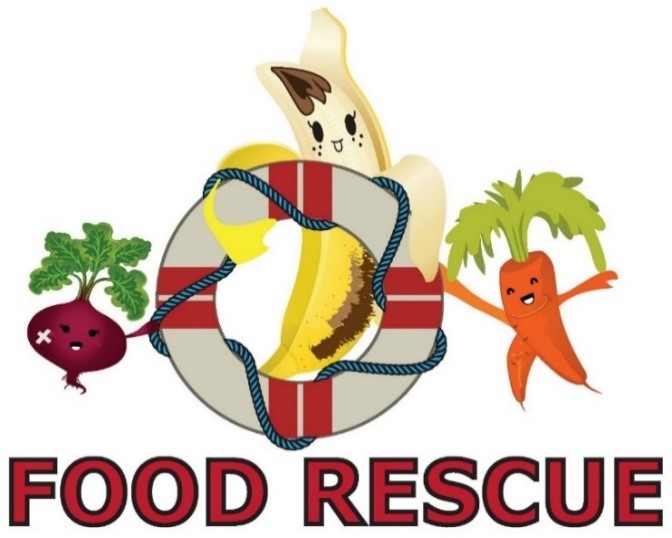
by wemakedo | Apr 10, 2017 | community, reuse |
Can you believe that estimates suggest that we are throwing away something like 30 to 40% of the food we produce globally! Amazing, when you consider the efforts that go into the use of chemicals and methods to enhance crop yields in order to boost production. It seems that there is way more food produced than we need to feed everyone if we stopped throwing so much of it away.
We wanted to share our experience with food waste reduction and our very first Food Rescue event!
As we’ve shown here, we started paying attention to our plastic waste and one thing leads to another and now we’re starting to keep a close eye on our food waste at home too. With 3 kids this can get out of control if one isn’t paying attention and it all part of wider intention to reduce our own waste and impact as much as we can.
Mrs Makedo recently became chairperson on the local primary school parents committee which our eldest girl attends. The main job at hand is to raise funds for the school. Traditional routes for fundraising seem to be hitting up businesses for raffle prizes, hitting up the locals for raffle tickets and hanging around outside the local church with a sign to hit up the churchgoers. These methods have been tried and tested and still work, but some new approaches could help the energy levels all round.
In a nice convergence of our waste philosophy and the need to raise funds for this new role, we got down to planning our first Food Rescue to raise some funds for the school.
If you haven’t heard, a Food Rescue is an initiative by Voice Ireland, an environmental group based in Dublin who ran the popular Feeding the 5000 Event. These events sprang from an acknowledgement of the huge volumes of food waste we generate. In particular food sellers are obliged to remove produce that is beyond the best- before date, but which is still perfectly fit for consumption. Similarly, funny looking veggies that are deemed too ugly to sell (in our world where appearance means a lot) can be rescued from the bin. Organizing an event where this food is rescued and used to cook up a tasty meal and bring people together to share it is known as a “Food Rescue”. And its purpose is to highlight the issue of food waste while using up some fine unloved produce to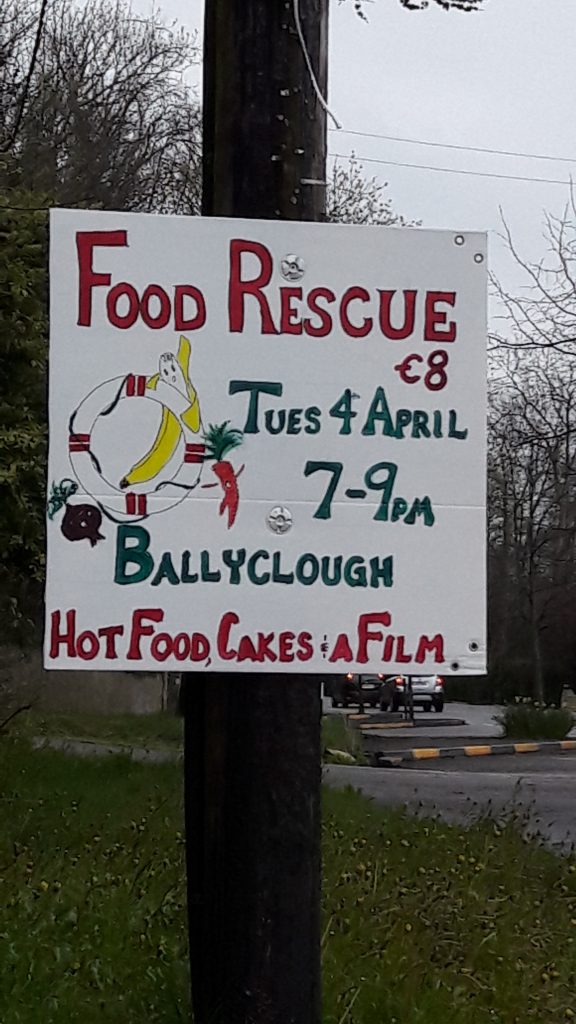 demonstrate it.
demonstrate it.
Mrs Wemakedo worked with Voice Ireland and put in several weeks of planning for the event which was held in our local community Hall on April 4th. A local high end restaurant chef (from Longueville House) was recruited to do the food preparation before the event. And we spent a few evenings handpainting some signs for advertising.
We did lots of cold calling supermarkets to see what sort of waste they have and how they could help, until we figured out that Food.Cloud have got this whole process streamlined to perfection. They have an extensive network throughout Ireland and have connected to all the supermarket chains to collect waste and find ways to use it through charities.
We found when we contacted them that they were ready to help in any way. They can source almost any kind of food at short notice and deliver to you for cooking – fantastic! Lots of successful Rescue events have been organized across the country for many years now so it’s a brisk business and one that appears to be having a great impact. People seem to know about this supermarket waste issue now. Household waste is a more personal problem and one that we can all probably do better with.
To add some variety to the event we included a viewing of the movie “Just eat it”. A very entertaining documentary about a couple who opted to live on waste food for 6 months, only spent $200 on food over that period and rescued about $20,000 from dumpsters. It has some very funny moments and is well worth a watch! We had a great response to this and people were very happy to sit through the 50 minute version. 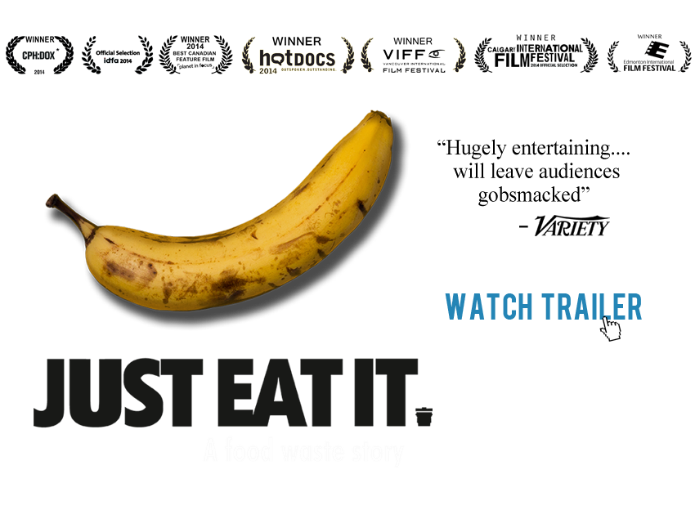
We also invited local composting expert Donal O’Leary from www.stopfoodwaste.ie along to talk to people about how to use food waste in beneficial way through composting it for your garden. He spent 30 minutes explaining all the reasons why keeping food out of landfill is important and the tricks to make it work for your garden.
The night went off really well.
Tons of super volunteers cooked cakes, provided tea/coffee to accompany the (rescued) main course and dessert and helped out with serving and clearing up. We had rescued biscuits, cheese and crisps also laid on. With an €8 charge on the door, the night attracted 80 or so guests and €600 euros was raised to help the school. We even had 2 couples attending who wanted to organize their own Food Rescues.
The Rescue idea has huge potential and with this first trial run, the hope is to make it an annual event. We were a little cautious with the food this first time round, but having seen how it all works and the excellent message it gives, we would hope to go much further with the rescued food on offer in future.
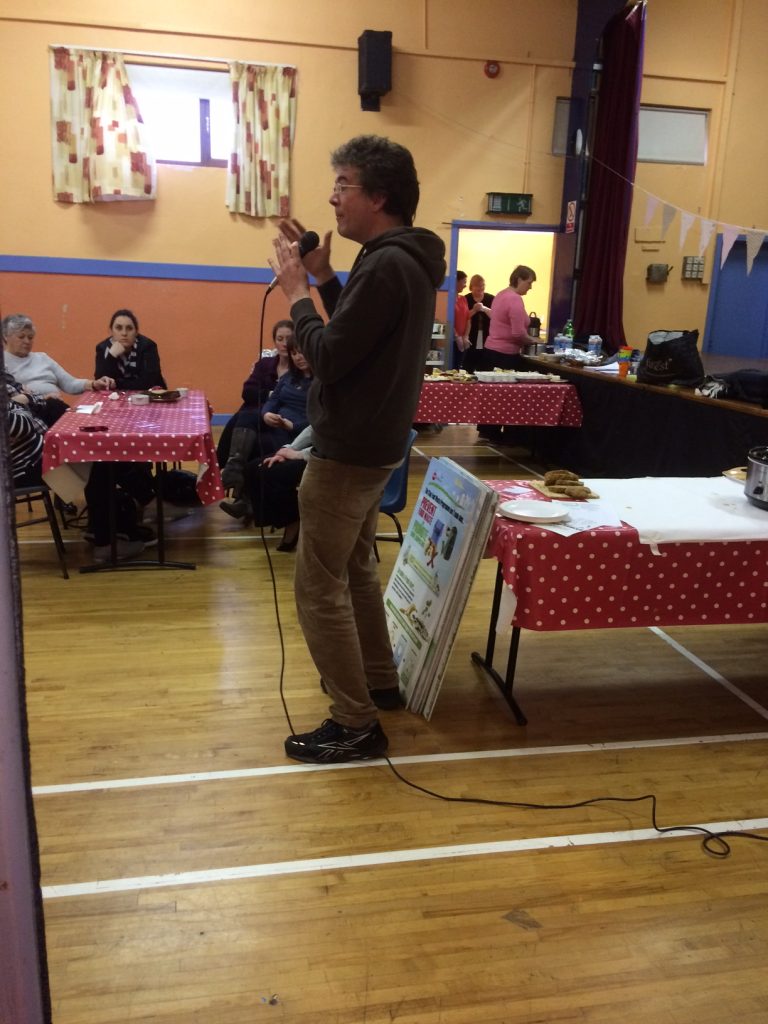
Donal O’Leary from www.stopfood waste discussing composting.
We were so busy on the night that we only took 1 picture. Here it is!
And if you’d like to organize your own Food Rescue, simply contact Mindy or Meaghan from Voice Ireland, and they’ll send you everything you need to get started!
Here are some interesting points about global food waste: (source – www.foodtank.com)
- 3 billion tons of food are wasted every year
- If wasted food was a country, it would be the third largest producer of carbon dioxide in the world, after the United States and China
- Just one quarter of all wasted food could feed the 795 million undernourished people around the world who suffer from hunger
- Food waste in rich countries (222 million tons) is approximately equivalent to all of the food produced in Sub-Saharan Africa (230 million tons)
- A European or North American consumer wastes almost 100 kilograms of food annually, which is more than his or her weight (70 kilograms)
- A European or North American consumer wastes 15 times more food than a typical African consumer
- Food waste in Europe alone could feed 200 million hungry people
Some related links:
www.voiceireland.org
http://www.stopfoodwaste.ie/
www.food.cloud/
by wemakedo | Feb 20, 2017 | health |
Home water quality is important and for us it was an issue.
When we first built our house back in 2010 we opted for installing a well on our property as connecting to the local water mains was just too expensive – it was too far from our house to connect in at a reasonable cost. Plus the idea of having control over our own supply was in keeping with our self-sufficient approach.
When the well was sunk to a depth of 200ft we felt happy that the drainage through that amount of ground would do a good job of filtering 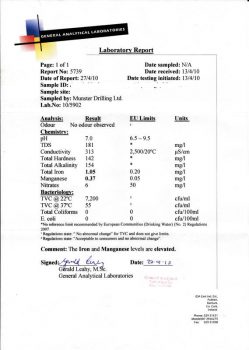 out any nasty stuff that the local landowners might want to dump on the land.
out any nasty stuff that the local landowners might want to dump on the land.
Unfortunately we were in an Iron rich area and so the water, although quite drinkable and clear had a relatively high iron and Mn content and also elevated hardness. Iron is classified as a secondary contaminant as it is does not impact health but is more a cosmetic and taste issue. When drinking a glass of water tastes like you have a bloody lip, then you just tend to avoid it!
On the advice or our plumber at the time, we went with some large passive filters to clean it up. This triple filter system (shown), used a first stage sediment mesh filter to remove particulates, a second stage carbon filter to remove contaminants by chemical adsorption and finally a third stage filter designed to remove Iron(Fe) and manganese (Mn).
 According to the supplier of the cartridges, which cost about Euros200 to replace, they should last up to a year for a house of 5 with typical consumption. Unfortunately for us we found that the problems with iron staining of our sinks, toilets and clothes never quite went away. In contrast, the hardness (Calcium carbonate) wasn’t much of an issue as it was not very high and it also adds a crisp freshness to the water flavor.
According to the supplier of the cartridges, which cost about Euros200 to replace, they should last up to a year for a house of 5 with typical consumption. Unfortunately for us we found that the problems with iron staining of our sinks, toilets and clothes never quite went away. In contrast, the hardness (Calcium carbonate) wasn’t much of an issue as it was not very high and it also adds a crisp freshness to the water flavor.
The carbon and sediment filters we installed appeared to be doing their job, but the iron filter simply wasn’t up to the task. On doing some research it seems there are different varieties of iron contamination in Irish water.
Water that comes out of the tap clear, but turns red or brown after standing contains “ferrous” iron. Water which is red or yellow when first drawn is “ferric” iron. Iron can form compounds with naturally occurring acids, and exist as “organic” iron. Organic iron is usually yellow or brown, but may be colorless. For the chemists: ferrous indicates Iron in a +2 oxidation state while ferric is iron in a +3 oxidation state. As far as we could tell, we had ferrous iron and the most commonly recommended way to remove it is by using a water softener (ion exchange resin based).
The presence of Mn will tend to create some black stains, and can give the water a bit of a bad smell, making your glass of water with meals even less appealing than the iron already makes it. Although both iron and manganese are harmless to health at these levels (1ppm and 0.37 ppm respectively), their combination in drinking water is a real problem – in that you won’t want to drink it. This is a bad situation with kids when you want to encourage to drink lots of water and less of the sugary alternatives.
When one goes looking for solutions, there seems to be much scaremongering about how specialized the water cleaning technology is. On making enquiries, we kept hearing that one daren’t make a purchasing decision without talking to “the experts” who want to sell you their specialized system that is perfect for your needs.
We received quotes from €900 to €1500 for a softener/ion exchange unit to fix our problem! Significantly more than we expected to pay for technology that seems really quite simple.
As with many other household technologies, the amount of available information online is helping to address the lack of information which forces buyers to be cornered into paying high prices. This is the rather excellent leveling effect of free information.
Armed with the knowledge that we had ferrous iron and manganese to remove as well as some hardness, we were able to avoid that first costly barrier of not knowing what we needed. That ignorance can unfortunately lead to some businesses taking advantage of those who come with a “can you understand and fix my problem for me” approach.
We found these guys (www.water2buy.ie) offered a high quality product and service designed for those willing to handle some of the leg work. Having spotted a sale price earlier in our searches, when we went back to finally make a purchase, that sale price was gone, but we were delighted that they were open to negotiation and in the end we got our new system delivered for €450 instead of the advertised €600. A whole lot less than our first enquiries forecasted.
The people at Water2buy.ie were able to assess our water analysis test results to confirm that this particular ion exchange resin would fix our problems which turned out to be correct. In the back of my mind I knew that once you have the hardware (a sealed cylinder, valves and plumping) that changing this particular resin for another option is relatively easy should there be issues later. So we felt quite happy to purchase without b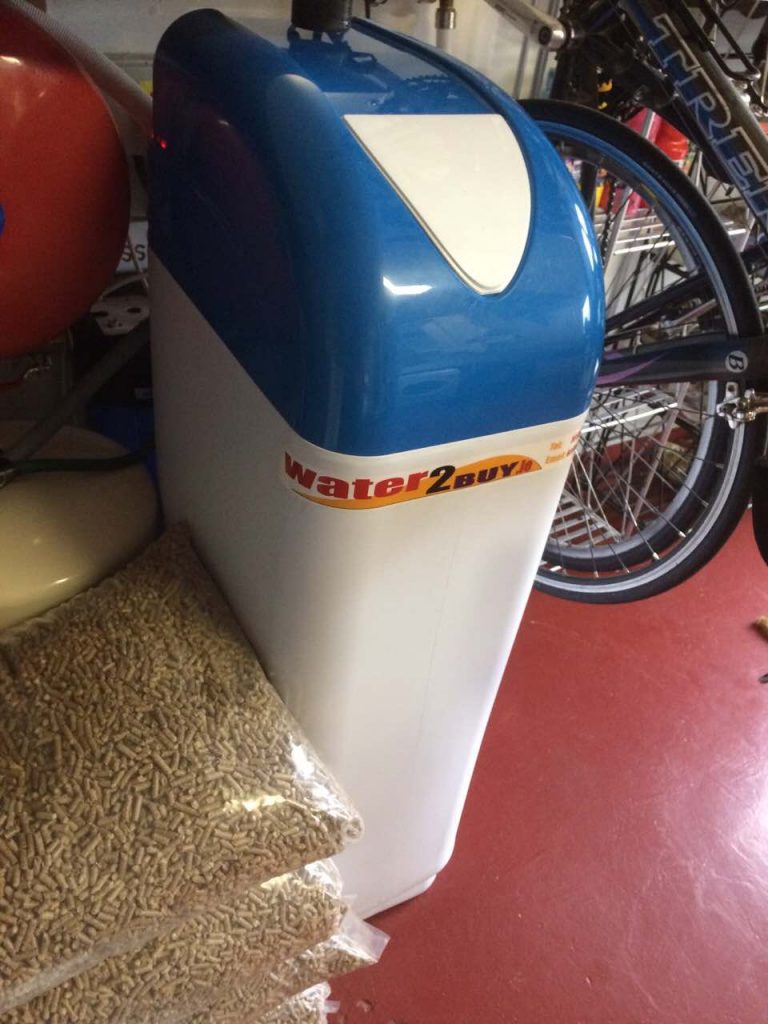 eing able to confirm that it would do the job.
eing able to confirm that it would do the job.
It turned out to be one of those rare completely successful fixes! We are thoroughly satisfied and are iron/manganese/lime free after 1.5 years of running now. As with all ion exchange processes the ions being exchanges with the unwanted contaminants need to be replenished – usually with rock salt. Through use of low flow fittings/toilets throughout our house we are down to approximately 1 x 20kg bag every 2 months. We didn’t opt for the more expensive flow based meter to set the flushing frequency, and instead went for the time based meter which just flushes at preset times regardless of the consumption. With some tweaking we managed to get it down to the point where it’s just enough to maintain the resin and so not much salt is being wasted.
The installation was easy and cost €80 with a local plumber to fit the additional lines to put the filter inline and also allow a bypass for when we needed to work on it.
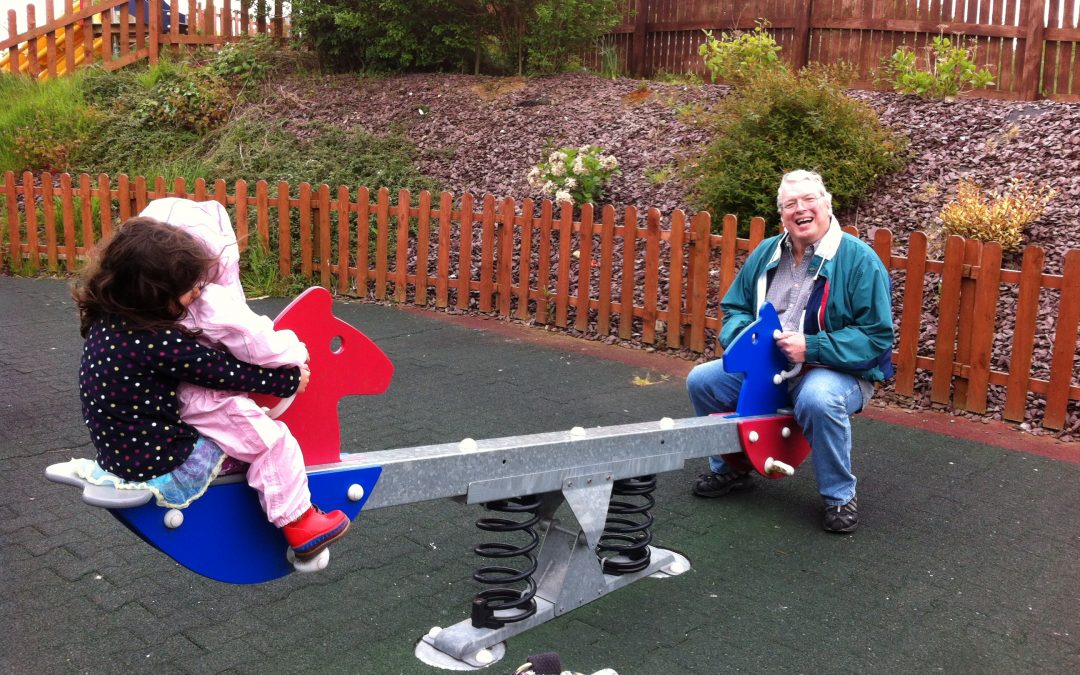
by wemakedo | Feb 4, 2017 | family |
The WeMakeDo family spent the Christmas period in Arizona this year. But unlike other family holidays, this one had a defined but very daunting purpose to it: To clear out Grandpa and Grandma MakeDo’s house of the past 40 years, to sell it and get them moved up to the Northwest to be closer to grandkids. What started as a challenging but seemingly attainable goal turned into a heart breaking experience, so poignant in its irony, that we feel it has to be shared for the message it conveys so clearly.
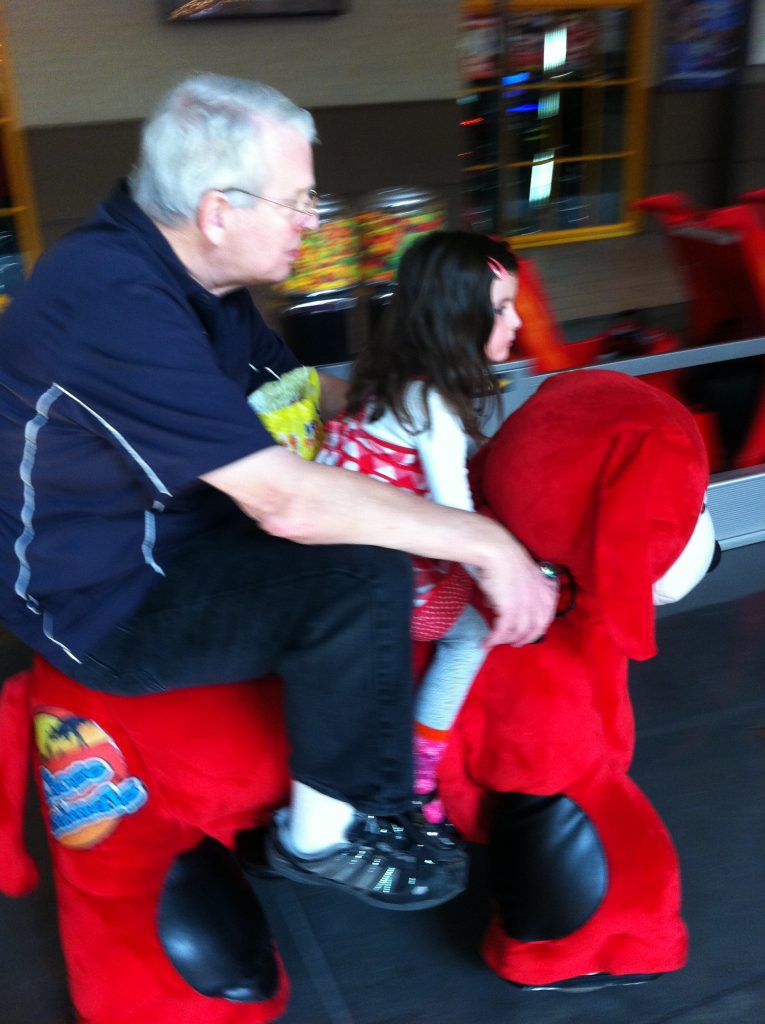 Grandpa MakeDo was the best Grandpa ever, with endless time and love for his grandkids. His lifetime dream was to live surrounded by his family – he used to use the phrase “family compound”, with the grandkids running freely between houses. But, 20 years on, they had somehow found themselves with kids gone and without much of a community around them. Elder isolation had crept in, and their quality of life was diminishing. When Mrs MakeDo would describe our set-up in Ireland to them, with the kids running over to their Nana’s house, Grandpa in particular would smile in envy. How lucky he said their Irish Grandma was, to have the kids and grandkids so near. In the US, unfortunately, most of us don’t live like this.
Grandpa MakeDo was the best Grandpa ever, with endless time and love for his grandkids. His lifetime dream was to live surrounded by his family – he used to use the phrase “family compound”, with the grandkids running freely between houses. But, 20 years on, they had somehow found themselves with kids gone and without much of a community around them. Elder isolation had crept in, and their quality of life was diminishing. When Mrs MakeDo would describe our set-up in Ireland to them, with the kids running over to their Nana’s house, Grandpa in particular would smile in envy. How lucky he said their Irish Grandma was, to have the kids and grandkids so near. In the US, unfortunately, most of us don’t live like this.
So the extended family came up with a plan. We’ll move Grandpa and Grandma up to the Pacific Northwest, where 8 members of the family were, including 3 grandkids. And then we’ll work on getting them a visa to live in Ireland, once the Washington family have had enough! Then Grandpa MakeDo’s life dream could finally come true.
That plan was hatched about 2 years ago and unfortunately never took off….
The problem was, Grandpa was a little bit of a hoarder. He loved electronics, and woodworking, and airplanes, and BOOKS! Piles of books that hadn’t been looked at in years. And every kind of tool imaginable. Coffee cans of screws and nails that ‘could be useful someday’. Furniture from his great grandma, and special cherrywood that he’d planned to build a desk out of in 1972. He couldn’t bear to part with any of it. His hobbies and passion for learning was what made him interesting and wonderful. But unfortunately, that’s also what prevented him and Grandma from selling the house and moving closer to family.
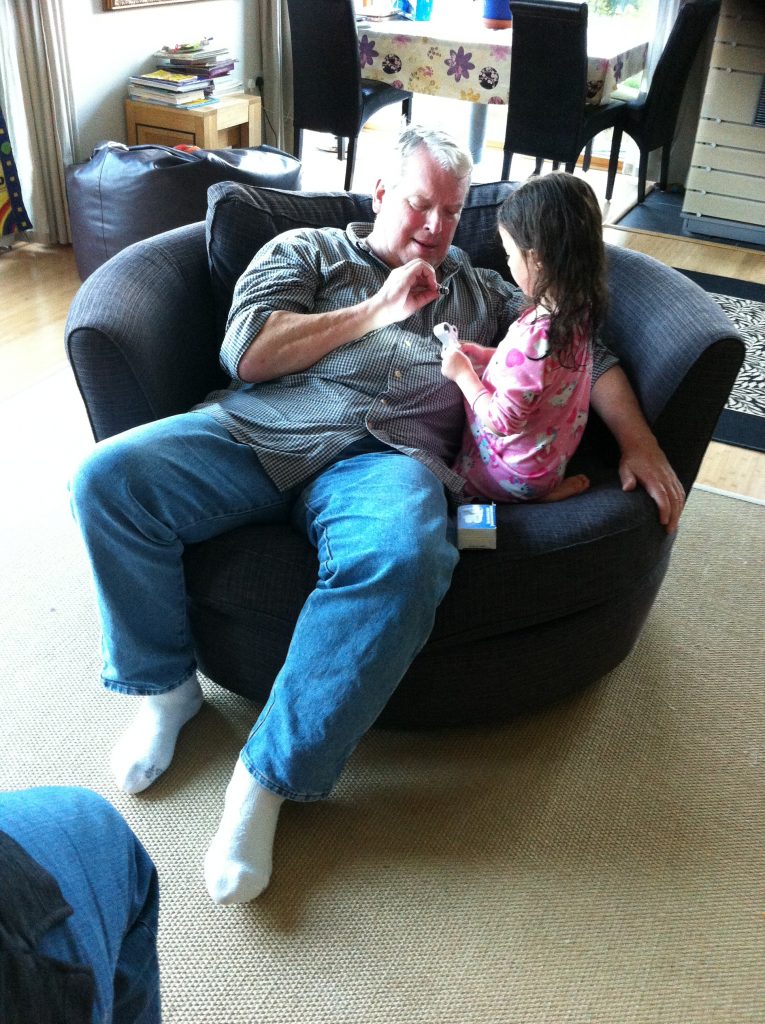 So, with a nagging feeling that time was of the essence, round 2 of the plan was devised and approved by all family. We (Mr & Mrs MakeDo) would come to Arizona to do the ugly work: Pry the possessions from a now fragile Grandpa MakeDo, by distracting him with the company of his grandkids. It worked beautifully, and after working nearly 10 hours a day for 3 weeks (a blog post for another day about the joys of dispositioning heaps of stuff to numerous amazing charities, and the wonderful support of friends and family who pulled together to support this effort), we decided we’d finished. So we rewarded ourselves by driving up to the mountains for a 2 day holiday-within-a-holiday.
So, with a nagging feeling that time was of the essence, round 2 of the plan was devised and approved by all family. We (Mr & Mrs MakeDo) would come to Arizona to do the ugly work: Pry the possessions from a now fragile Grandpa MakeDo, by distracting him with the company of his grandkids. It worked beautifully, and after working nearly 10 hours a day for 3 weeks (a blog post for another day about the joys of dispositioning heaps of stuff to numerous amazing charities, and the wonderful support of friends and family who pulled together to support this effort), we decided we’d finished. So we rewarded ourselves by driving up to the mountains for a 2 day holiday-within-a-holiday.
We arrived back to find that Grandpa had just been taken to hospital after collapsing at a doctor’s appointment. The next day was our eldest child’s 6th birthday, which we planned to celebrate by sneaking the kids and chocolate cake & candles into Grandpa’s hospital room. When we got there, he was not in any shape for celebrating. His last words were a warm Happy Birthday to our eldest, and telling them how much he loved them as he hugged them. And a few days later, he was gone.
The fist pounding, frustrating, horrible irony of this all is that his stuff prevented him from realizing his lifelong dream. This plan was never able to get off the ground over the previous 2 years due to the overwhelming burden of their possessions. It was just too difficult and a source of too much contention to start to tackle the stuff that needed to be sifted through. This meant that Grandpa did not get to spend the last few years of his life around his grand kids as was his dream. And, too much of his last few weeks were taken up in dealing with stuff and what to do with it: Issues like some missing items, lost due to all the moving around that was going on…..where should things go that were just too big to take but too good to give away …what price should we ask for some tools that were too good to donate etc. etc. Surely these things we accrue during our lives do not deserve to take so much of our time as they can do especially when it is so, so precious.
We returned home heartbroken….and even more determined not to let our stuff dictate to us under any circumstances.
Apologies for the lack of communication here for a while, but we couldn’t find the words.
“Onward and upward” as Grandpa would say…
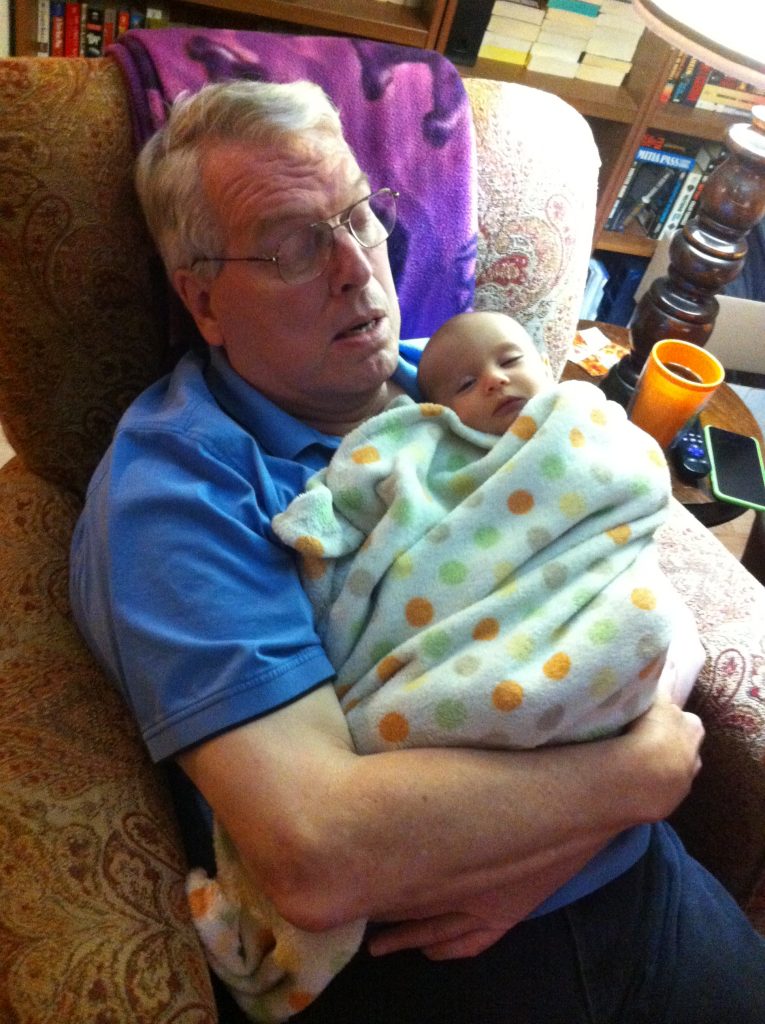
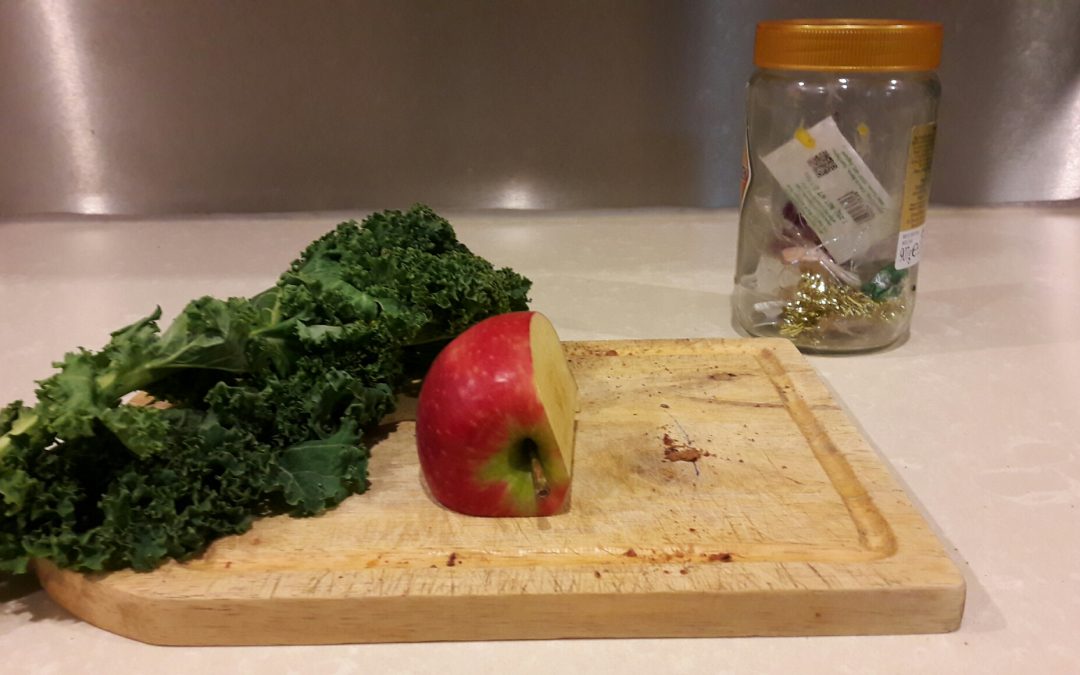
by wemakedo | Dec 3, 2016 | Plastic Free July |
It’s been a few months now since we started trying to minimize our household waste. The strange thing is that it’s been a lot easier than expected to keep ourselves at the much reduced waste level compared to where we were at initially …but very hard to progress beyond it.
We kept our glass jar on the counter as our waste bin so as to keep the focus for everyone in the house. We regularly comment on how full or empty its looking but generally speaking the half liter sized jar fills up in a week or so.
Not bad.
But then a plastic “recycling” bin crept back into use and it has a life of its own.
With kids, it seems nearly impossible to control the level of plastic coming into our house. Things like birthday parties, gifts from well-meaning friends and one-off purchases for them keep catching us out.
The Kitchen and general household stuff that goes into the glass jar/bin is well under control at this stage because we are now used to managing our regular household purchases. But there seems to be an endless stream of unusual plastic rubbish coming our way – sometime too big to fit – and so we’ve kept a larger recycling bag on the go.
Let’s focus on the positives first though. We have kept the habit of buying at farmers markets and SuperValu – still the best chain for unpackaged fruit and veg. And we have managed to maintain all our regular food related purchases at near zero waste level. Our old bin under the sink hasn’t returned, and neither have any of the other bins around the house. And we’ve gotten used to not looking for them and instead stuck with our new means of disposing of things.
For example when wiping down the table after a particularly messy meal, the stuff now goes either to composting or the chickens. Or in rare cases when cooked leftovers stay in the fridge too long and need to go, we have resorted to flushing them down the toilet. A perfectly fine option when not done too often.
For some items we still can’t find plastic /waste free alternatives and so we have done the best we could..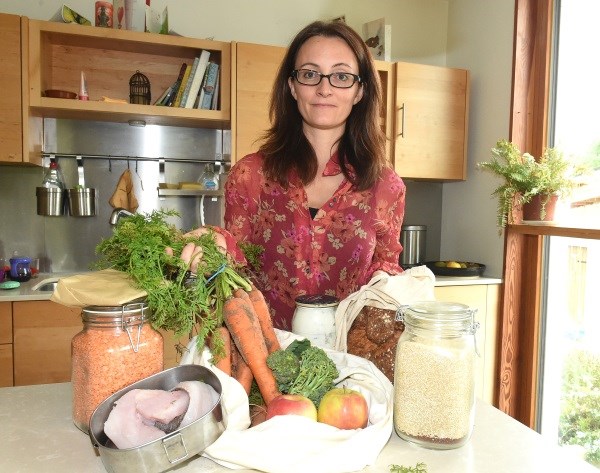
For example the raisins we now buy in large bulk (plastic) bags from Nutsinbulk. But it involves a lot less packaging waste than we used to create using the small plastic packs of raisins.
Our milk we now get mostly from “Siopa gan Ainm” on CornMarket street in Cork. They get it from a farm in Clonakilty – it costs €1.50 for a liter and you get 50 cent back when the bottle is returned.
Yoghurt and cereal are still all home-made now and the kids prefer the granola over other cereals, while porridge has always been available in paper bags. We’re looking into a possible source of large bulk bags of porridge too as we seem to burn through the stuff at a high rate – especially with granola making.
We’ve even been investing in some stainless steel containers to avoid putting the foods like fish or cheese into plastic reusable containers. One starts to feel like plastic should be avoided anywhere food is involved.
We haven’t figured out a way to source butter in some recyclable or unpackaged form.
Reusable nappies and non-disposable wipes (aka rags) has become second nature now for our youngest who has another couple of years of nappied life to go.
We bought bamboo toothbrushes, but have found that they’re not as nice to use as the regular plastic ones. This is more to do with the basic design of the bristles and their texture than the handle, but not sure if we’ll buy those again.
Shampoo bars are now second nature too for everyone in the family.
Toothpaste is still a problem.
We tried and failed to find toilet paper that isn’t wrapped in plastic too. Although we have a plan here…the use of bidet guns are the way to go. We might write about this in the future if modesty permits.
Also our composting has become a little more flexible and so some cooked foods are now going in there where we can’t figure out alternative…i.e. waste food that neither cats nor chickens would eat. So far this seems to be fine as our composters are good and big. But we’re conscious that too much may start to make the composters smell, so we won’t abuse this option.
We have taken one batch of non-recyclable waste for disposal since we started this back in May/June which is nice. This is down from what ordinarily might have been about 3 or 4 batches, but we do intend to try to improve this further
All in all making these changes, although daunting in the beginning are proving to be very easy to stick with. It feels like another push is needed to improve further – perhaps in the New Year, but we don’t seem to have slipped back into old habits and are planning to stick with this.
Our appearance in The Examiner drew a lot of feedback from our friends, and it was nice to hear of people who enjoyed the article and felt motivated to try similar efforts in their own homes. From a grandmother who’s now getting her grown daughters to shop plastic free, to another friend who asked for a shopping consultation!
Others felt that “we must have too much time on our hands” which we thought was an interesting viewpoint. In response to that, like with most things, we all have less time than we would like. Getting certain things done just means that you move things up your priority list. I.e. you will do things that you feel are most important to get done first and other things will always fall off the bottom of the list. For us, this waste problem suddenly felt very important, and how we were going to respond to it became even more important. Suddenly there was less time for watching a movie or for reading a book and more time given to making homemade granola or yoghurt or trying to find bulk raisins.

by wemakedo | Nov 11, 2016 | money |
A large part of our WeMakeDo philosophy is removing waste from our lives and building in self sufficiency where we can, mostly because of the satisfaction it brings but also because of the cost savings. We want to have a low-cost life and have set the goal for ourselves to live on 30-35k per year for our family of 5 while still living as well as we want to. This is in part so that we don’t have the constant pressure of having to make lots of money to live as we choose but more-so because it just removes a lot of the hassles from our lives that tend to come from extravagant spending. Putting it another way – breaking the cycle of needing lots of money to feed consumption habits that lead to lots of stuff and hassle that then requires more money and time to maintain.
With this approach in mind it makes a lot of sense to have your money work hard when it’s not being spent and so we have spent a lot of time and effort examining the options available to make your saved money work for you and provide some useful income
In this post we wanted to share three topics:
- A must read blog from a person in the US who has successfully designed his family lifestyle to allow him to retire at age 30 and to live how he wants on $25k per year which comes from interest on his savings if he chooses not to earn money with his time.
- 2 options you may not have heard about if you have savings that need to do some more work with a little risk.
The blog..
An online hero of ours had been writing about his life choices for over 4 years now and these choices have allowed him to retire from salaried life at age 30 with his wife and child and he is now over 12 years on this path. It’s important to note that it was never his intent to sit around and do nothing, but instead to control his finances in a way that allowed him to have the freedom to choose how he spent his time doing when not forced to follow a salary. He writes excellently about how he has achieved this through removing unnecessary spending from his life while making his saved money work, all the while leading the satisfying life that he wants to live without earning a salary. Unless one starts adopting this approach early in life, achieving his outcomes are not easy, but there is plenty to take from this philosophy of not consuming wastefully and taking control of ones finances : check out the story here www.mrmoneymoustache.com or alternatively you can watch Pete (Mr Money) describe his lifestyle at this excellent talk from the World Domination Summit.
The savings growth options..
In the current low interest times, savings are no longer a worthwhile option, as the paltry rates are nowhere close to inflation and so money in banks although somewhat protected from wasteful urges is not exactly working. The problem is that the only other way to have your savings grow is to subject them to risk at varying levels. The stock market is the most well known vehicle for putting money to work with different levels of risk involved. With global interest rates as low as they are, big investor money is chasing one of the few places to still make money through stocks which has had the effect of driving US markets to all-time highs. The US markets have returned to the peaks they reached before the crash in 2007/2008 and now fear is beginning to return as people wonder how much longer this can continue with some economies on shaky ground in places like Europe and China. One way to still take part but to minimize the risks is to buy into funds that are spread across broad areas of the market and to do this in an automated way over a longer term which aims to take advantage of the general upward trend of markets.
Roboadvisors: These are a new breed of money management companies that have simplified and automated the process of making your money work in stocks and funds with very low fees. These Robo-advisor companies will manage your money and use it to buy into funds where you specify the risk level you are happy with. They automate the process of adjusting your investments to take account of changes in the risk levels of different assets and do this rebalancing using algorithms which work without your involvement. They will also manage the reinvestment of dividends and income. The nice thing about this service is that you don’t have to spend time watching and fretting about whether it’s invested in the right place, and historical evidence has shown that if you buy in and hold over the long term, the stock markets are always going up despite crashes of varying sizes along the way. Data shows that for US markets at least, the average annual return is approximately 7% over the longer term (10% before taking account of inflation). Thus buying and holding using these automated services looks very attractive and our friend MrMoneyMoustache has plenty of data on his site showing the performance of his investments using one of the better known US Roboadvisors. The UK equivalents do pretty much the same thing. I plan on investigating these more with a view to jumping in. We’ll report back if we do.
Some noted options:
Peer to Peer (P2P) Lending: This is a relatively recent addition to the “sharing economy” and is a service which makes use of peoples willingness to lend their money to borrowers in conditions where banks might not want to lend. In some cases this can be because the borrowers are considered too risky but in other cases it may be too short duration with too high a loan to value ratio. These companies pay their lenders well for putting up with the risk. One such example I have dabbled in is : www.Savingstream.co.uk.

These guys will pay you 12% interest per year on money that is used to make up short term loans for properties and development projects. They say they have a rigorous vetting process to make sure they only take on borrowers with low risk of defaulting. But be warned: if a borrower does default, then the money you have invested which part funded this loan may be at risk, although the model allows for the sale of the asset to be used to recoup the loan for investors and since 2013 this particular company has a 100% record in repaying the loans.
It’s not a place for alot of your long term savings but certainly can be considered as an easy way to generate some very good income on savings with a reasonably low level of risk.
At some future point we will update on how our income experiment with this company is going.
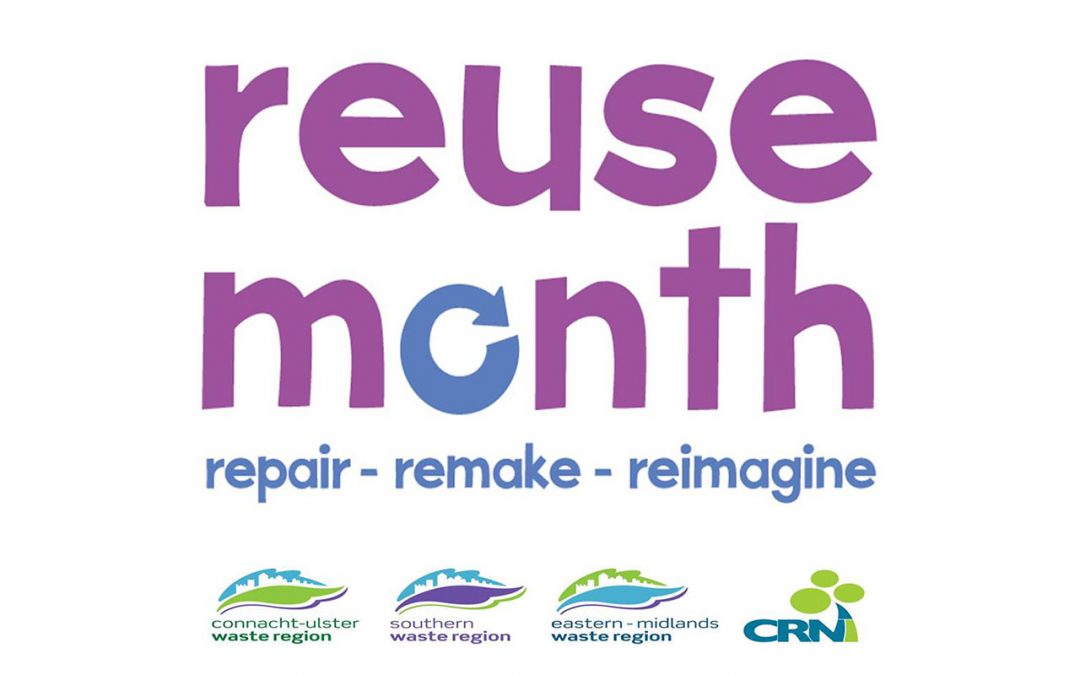
by wemakedo | Oct 14, 2016 | reuse |
Clearing stuff from your life to make space for better things..
There is no doubt that stuff brings hassle. Of course stuff bring utility value and pleasure is many ways but if we are honest about the stuff we have chosen to surround ourselves with, does it all continue to bring pleasure and usefulness after that initial perceived need has passed or does some of it become a burden when the novelty has worn off or some small part has broken and repairing it just isn’t worth the effort?
Our WeMakeDo family has recently chosen to get more ruthless about the stuff we choose to keep in the house and even more ruthless about what new things we bring into the house. When we did some reading from the many resources that discuss decluttering, it is suggested that there are additional beneficial effects when you start to reduce the amount of things you surround yourself with and need to be concerned about. You might think of it as a Feng-Shui kinda thing…or maybe that having more physical space in your home can translate into more mental space in your life.
We have generally scrutinized purchases well in advance of making them – i.e. discussed between us whether we really want one of these (whatever it happens to be) before making the purchase. Then we try to be conscientious about either repairing damaged items to get more life from them or moving them on when we think no more value can be had. But when one starts to think about the quantity of household waste we generate (as we did recently in trying to go plastic free and zero waste) it’s clear that avoiding plastic wrapping on your groceries isn’t so impact-ful if you are buying and dumping much larger household items on a regular basis.
Stuff adds complexity to your life and takes from the time you have that is not already absorbed by the non-negotiable demands we all have. Spending time with our kids is one area where we all should probably do more but it tends to compete with the flexible time we have that can be spent dealing with the extra stuff in our lives – fretting over the stuff, maintaining / repairing the stuff, cleaning the stuff, paying for the stuff, etc. As a family that tries to maintain some self-sufficiency in terms of repairs and maintenance we have found that this certainly can be a big time sink and is at odds with many of the things we know are better use of our time (time with kids, hobbies, personal development, etc.). Consumerism has been teaching us that we can buy time savings from things..but these things bring additional costs in terms of your time and attention into your life beyond the first cash outlay. This is why we believe letting less of the non critical stuff into your life in the first place and then making sure it’s of high quality and likely to demand less time during its useful life is an important the first step to regaining control over your time.
To slow the accumulation of things in our home, we needed to change mindset and begin evaluating our purchases differently. What you purchase costs more than the price you pay on the day. Each additional thing you purchase will also use your time, energy, and effort once it’s in your home. You may be buying it for its apparent time saving benefits as portrayed by the company that wants your money, but sometimes there are less obvious costs of ownership that should alos be considered. Before making a purchase, you could begin asking yourself these questions:
- Is this item really needed – beyond the immediate need I’ve already convinced myself of and keeping in mind it will eventually need to be disposed of?
- Do I have a place to store it knowing it may be around for a long time? and do I want to give up that space to this thing?
- How much extra work and pleasure will this thing add to my life?
Others have put this more succinctly: we need to constantly think about our “Joy-Stuff balance”. More stuff tending to mean less joy beyond a certain threshold of utility value. There are different levels on this scale. For example buying and running a second car has a high cash cost, and high hassle cost but then if you decide it needs to be done then presumably the utility value derived is expected to be high (and presumably higher than the costs) – but is it really the case?.On the other end of the scale, did we really need to have a regular set of plates that we use every day and also a “good” set of plates that have literally been used a couple of times since we got married?.Our new answer to this is no and so they are gone to a better home to be reused by someone who can appreciate them. We have spent that last couple of weeks creating piles around the house of stuff that none of us has used in 6 months or that we don’t have any attachment too. It’s an easy question to ask yourself once you’re in the right frame of mind: “does this thing bring me joy?” or “would I care if it was gone?”
So far we’ve not had any difficulty in decisively answering this question and moving stuff we no longer want, on to friends and charity shops mostly and via Donedeal in some cases. An opportunity for some reuse we hope. We are now firmly on this path of decluttering our lives and we have found that as you remove more stuff there is a great associated feeling of well-being that increases as you live with fewer things. We’re hooked and enjoying the process immensely! Most importantly it makes you scrutinize what you buy and why. This is not driven by money savings but instead driven by not wanted to refill your life with more stuff unless “necessary” and “necessary” now has a new meaning!
October has been designated as “National Reuse Month” by the Community Reuse Network of Ireland. They are urging us to pledge to reuse more during the month. We are hoping to give away as much of our unused stuff as we can to others who are willing to reuse it for us – as classic win-win situation wouldn’t you agree?
For more ideas about reuse opportunities – check out our “Make” page where we show some items we’ve repurposed in different ways
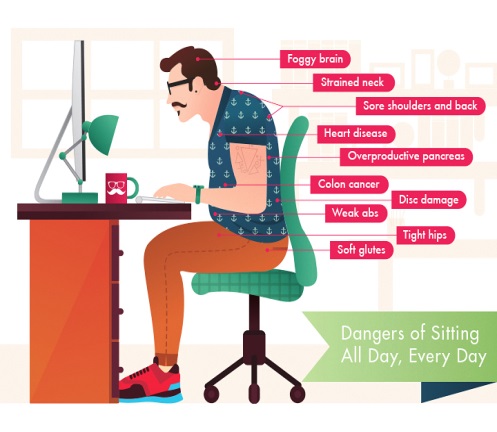
by wemakedo | Sep 23, 2016 | health |
In this post we stray a little from our recent interests in self sufficiency and minimizing waste to discuss a health concern we learned about that we felt important enough to share.
There is a lot of recent writing about the dangers associated with a sedentary lifestyle. Those of us who spend our day sitting at a desk or in front of a computer are told that we should exercise more. But what if the problem is not just the lack of exercise, but the actual sitting itself? It does seem somewhat intuitive that sitting down and hunching over a PC for hours during the day is not really what our bodies were meant to be doing. The convention at most office workplaces has meant that we now sit for up to 8 hours each day with few breaks, then drive home (seated) and possibly sit for more hours in the evening for relaxation. I myself have spent many hours doing so for nearly 20 years now. Thankfully I work for a company that is very aware of the ergonomic risks associated with the standard desk work setup and much effort is spent on educating people about the risks of repetitive strain injuries. This may help prevent aches and pains, but what about the more serious risks?
I came across this article and discovered it was one of many summarizing the newly identified dangers associated with sitting for extended periods.
To highlight some findings in the article:
One study compared adults who spent less than two hours a day seated (in front of the TV or other screen-based activity) with those who logged more than four hours a day of recreational screen time. Those with greater screen time (seated time) had:
- A nearly 50 percent increased risk of death from any cause
- About a 125 percent increased risk of events associated with cardiovascular disease, such as chest pain (angina) or heart attack
To me, these are shocking numbers caused by something considered so benign. The article goes on to say that these damaging effects are not counteracted by gym time or other exercise – the damage from sitting is done and remains. Some other headlines declared that sitting was “the new smoking”. I knew I had to do something about this.
Standing desks are nothing new, but in my experience they were reserved for people with significant back problems and the standing office arrangements tended to be prescribed for those issues. I was so bothered by the apparent health effects that I had to try this out. Getting a state of the art electrically adjustable standing / seating desk will cost from €1000 upwards, and so I wanted to be sure I could or would stick with this for the longer term before spending the money.
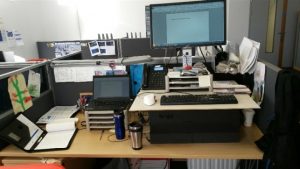 You can see my DIY version here. I am happy to report it works very well. Those are packing Styrofoam blocks under a board that my keyboard is sitting on. The height should be such that your elbows are at approximately 90 degrees w
You can see my DIY version here. I am happy to report it works very well. Those are packing Styrofoam blocks under a board that my keyboard is sitting on. The height should be such that your elbows are at approximately 90 degrees w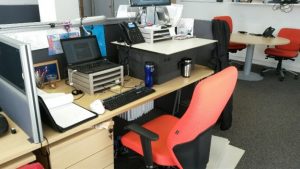 hen using the keyboard, and the monitor top should be at your eye level. In my case I had the luxury of being able to leave space for my laptop at a lower level as well as being able to easily switch the mouse and keyboard from the higher position to the lower position providing the easy option to sit when I wanted. This turns out to be necessary. I’m now sitting only 10-20% of the time I’m in front of the computer.
hen using the keyboard, and the monitor top should be at your eye level. In my case I had the luxury of being able to leave space for my laptop at a lower level as well as being able to easily switch the mouse and keyboard from the higher position to the lower position providing the easy option to sit when I wanted. This turns out to be necessary. I’m now sitting only 10-20% of the time I’m in front of the computer.
Standing for hours has its own risks and, depending on your physical condition, can tire you out quickly, so the best option would seem to be a mix of standing and sitting. The big advantage of standing for some of the work day is that, apart from keeping your metabolism running at a higher rate, you tend to move around a lot more on your feet, which is exactly why standing is so much better for your body.
Six months into my experiment and going strong, I have noticed:
- I work a little more efficiently as when standing I seem to be more attentive to what I’m doing and more eager to finish it.
- My posture has improved (shoulder droop is slowly reversing) – this seems to happen naturally as it’s more comfortable when standing to keep your back straight.
- I will more quickly walk away to do something I need to do as opposed to mentally deciding when seated, that you can wait until you need to get up to go do that thing. Walking up to your standing desk to engage in work, instead of flopping into a comfy chair seems to keep your brain more alert and attentive.
- I don’t get any post lunch slump anymore…you know that low energy feeling when a heavy lunch is being digested. Maybe it’s because standing and associated movements trigger metabolic processes that might otherwise stall while you are sitting and digesting your lunch
I should point out though that I did have some minor back pain during the first two weeks of doing this. It may just have been due to not adjusting my heights (keyboard, monitor) just right initially and then tweaking these over time. Or is may have been as simple as my back, curved over years by seated computing (see the image at the start of the article), was realigning and strengthening in areas it needed to use to keep me standing. Anyway, it passed, and now I have no hint of any back pain. But if you try this, be aware that you may experience this and may need to push through it, or it may be your body telling you that standing for lengths of time isn’t for you.
I do highly recommend giving this a try as I can honestly say I feel the benefits every day now, and I know it’s better for me. In a few years we may wonder at how we allowed this sedentary workplace practice to go unchecked for so long.
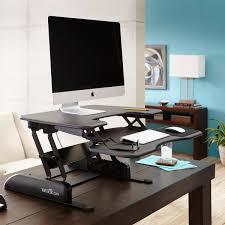
Also note that you can purchase cheaper standing alternatives like this one (Varidesk pro plus 30) to get you going, or as we prefer here at WeMakeDo…making your own from odds and ends is a very easy task and potentially life extending!

by wemakedo | Sep 10, 2016 | Uncategorized |
Here is how things were looking by Wednesday: 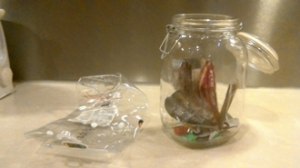 The jar was filling up but plenty of room left for the rest of the week. In the picture there is a large plastic wrapper from a set of school tights for our eldest girl. It was a spur of the moment purchase, one of those situations when we thought that avoiding plastic had to come second to getting the tights bought. I hadn’t bought tights in about 3 years, always waiting for hand me downs. I should have just sent her to school in socks for another week until I could have sourced some. There’s a plastic cat food pouch from a pack purchased ages ago (before we cared) – this will be avoided in the future by using canned meat and boxed nuts. Some fancy cheese we got as a gift had an inedible rind (we tried!!) so in that went too. All in all, we figured things were going fine.
The jar was filling up but plenty of room left for the rest of the week. In the picture there is a large plastic wrapper from a set of school tights for our eldest girl. It was a spur of the moment purchase, one of those situations when we thought that avoiding plastic had to come second to getting the tights bought. I hadn’t bought tights in about 3 years, always waiting for hand me downs. I should have just sent her to school in socks for another week until I could have sourced some. There’s a plastic cat food pouch from a pack purchased ages ago (before we cared) – this will be avoided in the future by using canned meat and boxed nuts. Some fancy cheese we got as a gift had an inedible rind (we tried!!) so in that went too. All in all, we figured things were going fine.
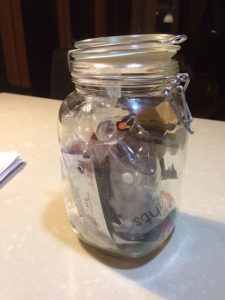 By the end of the week, we were delighted to see that we still hadn’t filled the glass jar. We found that we were taking a bit more liberty in what went into the composter (veg fried in oil??) and the hens were getting force fed potato skins and leftover toast that had a bit of jam on. The cat was given an extra day to finish the salmon skins. And mommy-eat-anything, the human garbage dump, ate any other scraps that would normally go in the bin.
By the end of the week, we were delighted to see that we still hadn’t filled the glass jar. We found that we were taking a bit more liberty in what went into the composter (veg fried in oil??) and the hens were getting force fed potato skins and leftover toast that had a bit of jam on. The cat was given an extra day to finish the salmon skins. And mommy-eat-anything, the human garbage dump, ate any other scraps that would normally go in the bin.
Here’s the overview of our junk for the week, and how we hope to eliminate each of the items:
Crisp bag from Joe’s Farm Crisps: The package is made from repurposed coffee bean bags, which is how I justified this yummy purchase. It is still my rubbish though. Not sure what to do with it. Maybe this will be an every other week indulgence..
Cat Food bag and School Tights bag: See above. Tin cans for the cat from now on, along with Whiskas cardboard boxed cat nuts. And the new tights… what was I thinking! This was a good reminder that something might not be as essential to puchase on the spur of the moment as it seems.
Cheese Rind & Wax: We eat lots of cheese… I found some recipes using cheese rinds to make stock. The wax might be compostable. We should be able to find a use or a waste free disposal option for these.
Dishwasher tab wrappers: These were bought in bulk with a Groupon voucher before we were concerned about the packaging. We’ll use them up then source non-packaged dishwasher soap (like the old cardboard boxes of Cascade that we used to use in Alaska..)
Tea Bag Covers: We won’t be buying tea bags with wrappers on them anymore. In fact, we’ll aim to switch to loose tea from a shop in Cork.
Yogurt Pot Covers: Mr MakeDo loves his lemon custard yogurt. I started making homemade yogurt in July, and just this week figured out that adding lemon curd to homemade yogurt nearly replaces his favourite yogurt. So, these will be eliminated. We recycled the paper pots (hmmm, better check that’s allowed…)
Cream Cheese Cover: I made courgette cake, which had to have cream cheese icing on it. Indulgence. We do use the cream cheese pots for lunches, but we don’t need that many. Maybe I’ll look for a homemade recipe for cream cheese. For now, though, we’ll reduce the cream cheese purchases.
TetraPak pull tabs: We need to come up with a plan to reduce Tetrapak use. We’ll post here when we do!
Expired Hairbands and Rubber Bands: No idea what to do with these yet. Suggestions welcome!
Gum Wrappers: Gum is gross – our 5 year old needs to find something else to be obsessed with. It hopefully won’t appear again.
Fruit Sticky Labels: Shopping at the Farmer’s Markets will eliminate the fruit labels, while the fruit is in season. Not a huge amount of waste, but it all counts.
Salmon Skins (not pictured here): The cat ate most of them, but we’re going to see if we can bury them or chop them up finely and compost them. I’ll ask the fishmonger what he does with the skins. Or I might ask him to skin them for me.
We also found that we should get better about cutting off inedible parts of veg before cooking them, since cooked stuff isn’t desirable in the composter. For example, pull the kale leaves off the stalks before making kale chips.
Of course a week is short enough that plenty of purchases in packaging that last longer wouldn’t reach end of life, and so won’t appear in this test. One example of this is that the family got head lice this week (!!!) and my first thought was how much room the delousing shampoo bottle would take up in our glass jar! But luckily, we bought a 6 treatment bottle, and only needed to shampoo 4 of us. So the bottle didn’t need to be discarded, yet.
Our glass jar will remain on our kitchen countertop, and the rest of the household bins will stay stacked and put away. I suppose we should warn guests.
An interesting side-effect of this high degree of attention to our household waste is that we are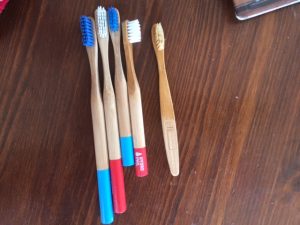 becoming even more keenly aware of the clutter in our home that we don’t need to have around. And so Zero Waste Week seems to have triggered a de-clutter month also. Some time is being spent rounding up things that we don’t love or enjoy using so much as we come across them. We hope that as this stuff leaves, that it wont get replaced by other similar stuff now that we have become more sensitive to the effects of consuming. Many of these items were things we picked up in our premarried lives that we are just no longer attached to. Some were posted for sale online and the rest will be offered to our local charity shop. We did order a set of bamboo toothbrushes (Eccoe-Verde), which we love!
becoming even more keenly aware of the clutter in our home that we don’t need to have around. And so Zero Waste Week seems to have triggered a de-clutter month also. Some time is being spent rounding up things that we don’t love or enjoy using so much as we come across them. We hope that as this stuff leaves, that it wont get replaced by other similar stuff now that we have become more sensitive to the effects of consuming. Many of these items were things we picked up in our premarried lives that we are just no longer attached to. Some were posted for sale online and the rest will be offered to our local charity shop. We did order a set of bamboo toothbrushes (Eccoe-Verde), which we love!
One other thing I’d like to mention is the use of reusable feminine products. Once you start using these, you’ll wonder why you never did before. They save a huge amount of money, and the cups are safer for you too by eliminating the risk of Toxic Shock Syndrome (TSS). Have a look at this gorgeous young lady, Lauren Singer, who’s a huge advocate, or here is a list of different alternatives for cups or pads.
I’d read about the joy that others experience as a result of minimizing, and I used to think it was a little bit corny. But, I have to admit to very much starting to feel that joy, as we move closer to having only the things we love and need. I’m already noticing more free time now that we spend less time cleaning up, throwing stuff away and taking out the rubbish.
If you want more motivation to reduce waste and minimize your stuff, have a look into Lauren Singer (mentioned above) or Bea Johnson, the queen of zero waste!
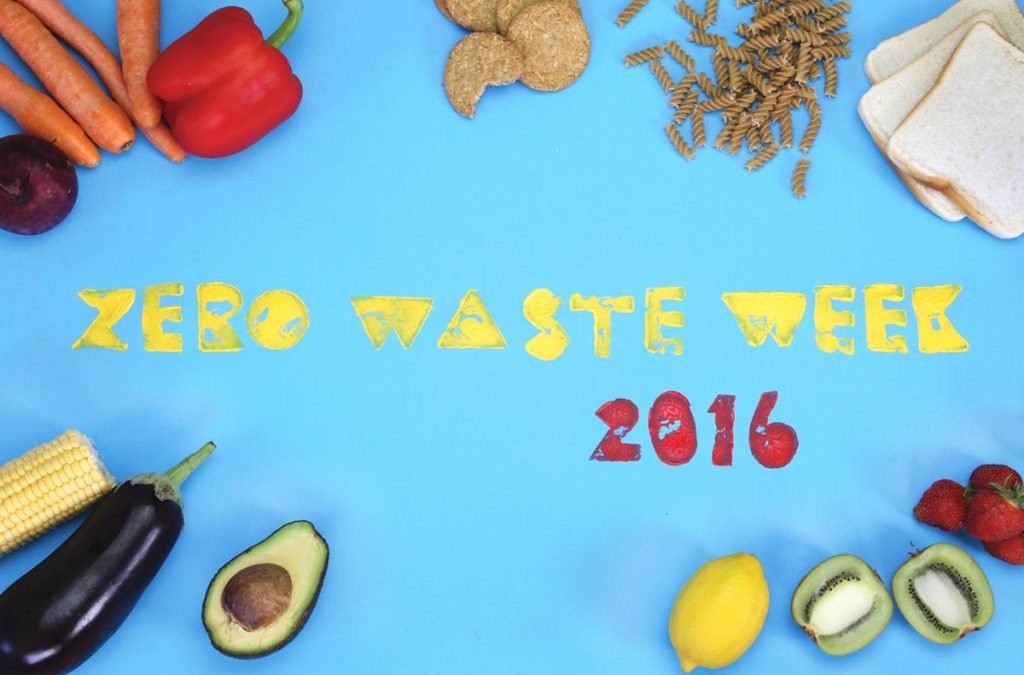
by wemakedo | Sep 5, 2016 | Uncategorized |
Having learned a lot from our experiences during plastic free July we intended to participate in the Zero waste week, starting Monday September 5th. Learning how to at least manage and control our use of single use plastics was an excellent starting point for attempting to lead the family towards trying to eliminate our household waste at least for a short period. Partaking in these organized waste efforts is a great way to coax everyone to pay attention to the problem and to play with ways to reduce. The kids are particularly interested in these experiments and love to get involved in the process.
Our plan of attack for the week will revolve around:
- Focus in particular on food waste, and reusing leftovers; for leftovers that we don’t use:
- Composting
- Expanding the diet of our trusty hens who are keen to eat almost anything we have tried on them that doesn’t go in the composter.
- Cat for any fish scraps we have (being a no meat household removes that issue for us)
- Zero plastic shopping – of course.
- These first few deal with the kitchen waste which for us is easily the biggest source of daily waste
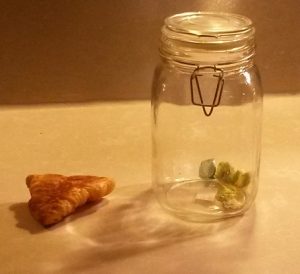 generation.
generation.
- Re-useable nappies all the way for our two kids who still need them
- No unnecessary purchasing which involves packaging of any kind.
Shown is a picture of our temporary bin which will have pride of place on our kitchen counter for the week, where everyone can see it and monitor our progress. We took the precautions of emptying and hiding all other bins in the house to start the week so we can clearly see what is being generated during the week. A leftover croissant was waiting for hen-breakfast but was later grabbed for a bedtime snack.
As with the plastic free effort, the goal here is not so much to minimise the waste but more to examine what we generate alot of and to look for alternatives. Zero waste feels like an unattainable goal but as many bloggers have demonstrated, it is a practical target to aim for and we can all make some changes to move in that direction at least.
With our family of 5, we needed to put a little more thought into preparing for areas such as nappies, school lunches and grocery shopping, but as our previous experience showed us, plastic was the issue for groceries and we found that our plastic free habits have stayed with us and it has become second nature now to just avoid plastic packaged foods. This has meant we now only shop at farmers markets and SuperValu, as well as the English Market in Cork.
Composting is also something that we have done for many years now and if you have the space in your garden it is an excellent way of reusing raw food scraps. We made our two bin composter from old pallets and a metal base from a kids cot, covered in roofing rubber membrane (leftover). We then lined it with plastic construction film (left over from our house build) to slow the breakdown of the wood. We fill one bin while the other full side breaks down, and have found that we can get good quality compost out from the full side in the time it takes us to fill the other bin. In August we emptied the latest batch of compost onto our veggie garden to help restore it.
So if you have the interest, join us for Zero waste week and learn more about what your household generates.
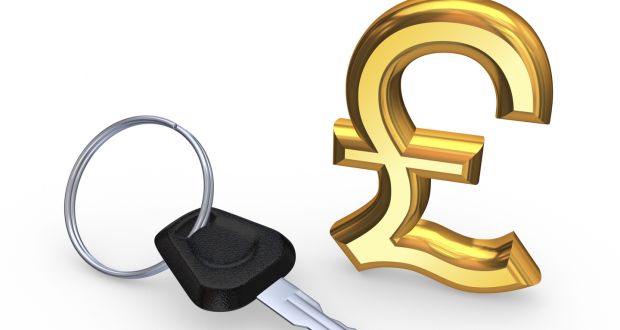
by wemakedo | Aug 21, 2016 | transport, Uncategorized |
Image courtesy of The Irish Times.
With the Euro / Sterling exchange rate recently becoming much more attractive for car buyers considering a UK import, we thought we’d describe our recent experience with this process for buying a car.
Our new arrival in November which brought the brood to three meant that we had to rethink our car situation. Neither of us care too much about the appearance or brand of car we drive but let’s face it, in rural Ireland one tends to spend a lot of time driving. So having a car that matches your needs makes moving the family around easier and maybe somewhat pleasant. Our VW Passat estate just wasn’t up to the job of managing three kids car seats easily. Having spent the winter in Alaska where our in-laws use MPVs, the obvious flexibility of these vehicles was compelling and as one gets older and busier with kids, one tends to look more at the practicality of things than the cosmetic appeal. We came home with the plan to upgrade (or downgrade depending on your view).
Figuring we’d save some cash, we opted to try to sell our own car first. So we cleaned it up, took some pretty pictures and posted our 2011 VW Passat estate online and watched the “views” roll in. Lots and lots of tyre kickers it seemed.
But no calls.
We dropped the price to try to spur the interest (14,500, down to 14,000).
Finally we had an interested person, the only interested person as it turned out, who came and viewed and bought. It only took about 6 weeks and we got 13,500 in the end. A decent price considering the advantage it gave us in making our next purchase.
For various reasons we had settled on a Peugeot 5008 7-seater as our replacement. Having bought a UK import before through a local dealer we decided to try this path again.
The exchange rate plays a big factor in whether this route is advantageous. At the time we started talking to a dealer about doing this, the Stlg/euro rate was at 1.27. Not a good exchange going by historic trends but surprisingly it was good enough to make a saving. The average UK car tends to be higher spec than the Irish equivalent and so the expectation is that you will get something at least nicer if not cheaper assuming the same year and mileage. For some it makes sense to travel to the UK, make the purchase and drive the car back to Ireland, sorting out the VRT payment along the way. We weren’t prepared to travel and so we opted for one of many dealers now who will offer this service for their own fees.
The appearance of online auction sites where buyers can get full bidding access has made this process much simpler than it used to be – both for dealers and private buyers it should be noted. In the two times we have been through this process, no one connected to the dealer was physically inspecting the car to ensure that it was good purchase. Instead the more reputable auction sites use a pre-check process that rates the cars according to their mechanical and cosmetic condition. Grade 1 is as new, and grade 3 is decent while a grade 5 might have warning lights showing or some serious bodywork issues. Apparently the dealers trust this assessment and rating enough to bid remotely on the car on your behalf. In other words they are not doing anything that you can’t do yourself except taking the logistical hassle out of the process. Also note that there is a fee for buying at these auctions which is related to how frequently you do it, and so a dealer will benefit here over the once-off buyer who pays more –for example 9.5% of the purchase price for a £10,000 value car was quoted on one site, which is significant.
One thing to beware of at this point: For a dealer who buys a car this way and then offers it to you with warranty cover, they are providing additional value on top of the car. Knowing that the car that was bought unseen will have a warranty with your local dealer certainly reduces the risk and brings some peace of mind. One dealer I bought from before did this but in this most recent case, the dealer has outsourced this to “Mapfre”, so for a discounted price I could buy a warranty from them for a year to cover the car. Apparently when you buy an extended warranty on a new car in Ireland It may be covered by this Spanish company based in ireland, so they are well established in this market.
The point for me though was that if I did buy this UK auction car myself and avoided having to pay a dealer to do it for me, then a concern was that I would not have a warranty, until I realized that I could buy one if I wanted. This makes the idea of doing this whole process myself quite feasible and with low risk.
Would I bother?
Certainly after going through this process and seeing how it works, and feeling that the dealer did little for his cut other than get the car shipped over to me and put through the VRT payment process, I would strongly consider it.
You get to pick your car, and importantly you get to bid yourself so you know exactly what you are willing to spend as the bidding is driving the price up during the auction. This avoids the difficulty of having to provide a bid limit to the dealer in advance without knowing if it will be enough for a successful outcome, only to find out later that you lost your ideal car to another bidder for the sake of another hundred quid.
Some useful links:
To transfer money from euros to sterling – I recommend avoiding banks and going with Transferwise a most excellent facility that charges the least for exchange transfers.
Of course we bought before “Brexit” happened, and so now the post- Brexit exchange rate being in your favour, makes this a most attractive option for those willing to put in the additional effort.

 demonstrate it.
demonstrate it.

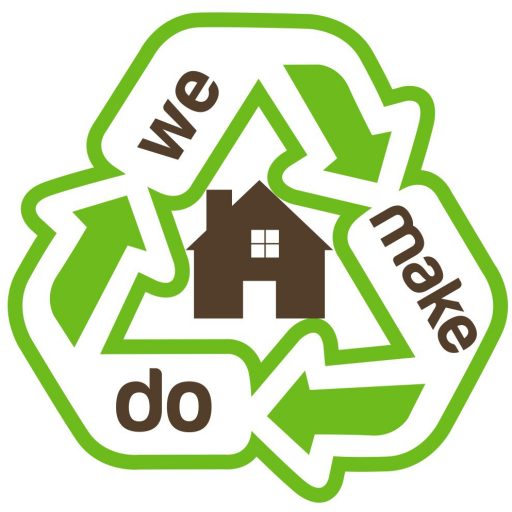





 Grandpa MakeDo was the best Grandpa ever, with endless time and love for his grandkids. His lifetime dream was to live surrounded by his family – he used to use the phrase “family compound”, with the grandkids running freely between houses. But, 20 years on, they had somehow found themselves with kids gone and without much of a community around them. Elder isolation had crept in, and their quality of life was diminishing. When Mrs MakeDo would describe our set-up in Ireland to them, with the kids running over to their Nana’s house, Grandpa in particular would smile in envy. How lucky he said their Irish Grandma was, to have the kids and grandkids so near. In the US, unfortunately, most of us don’t live like this.
Grandpa MakeDo was the best Grandpa ever, with endless time and love for his grandkids. His lifetime dream was to live surrounded by his family – he used to use the phrase “family compound”, with the grandkids running freely between houses. But, 20 years on, they had somehow found themselves with kids gone and without much of a community around them. Elder isolation had crept in, and their quality of life was diminishing. When Mrs MakeDo would describe our set-up in Ireland to them, with the kids running over to their Nana’s house, Grandpa in particular would smile in envy. How lucky he said their Irish Grandma was, to have the kids and grandkids so near. In the US, unfortunately, most of us don’t live like this.

















